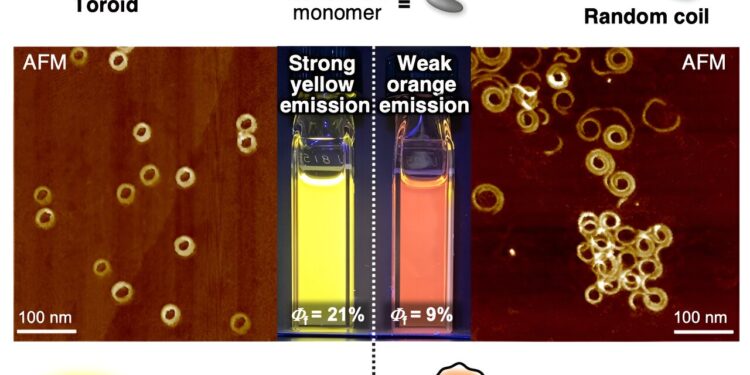(a) Unterminated toroidal assemblies do not easily deform in solution, resulting in less excitation energy loss and strong yellow fluorescence. (b) Randomly coiled assemblies easily deform, resulting in loss of excitation energy and weak orange fluorescence. Credit: Sho Takahashi, Chiba University, Japan
In supramolecular chemistry, the self-assembly state of molecules plays an important role in determining their tangible properties. Controlling the self-assembled state has attracted considerable attention because it can be exploited to design materials with desired properties such as charge transport capacity and fluorescence wavelength.
For years, scientists have been trying to understand the impact of molecular organization on the properties of supramolecular assemblies at the nanometric (<10 nm) and mesoscopic (10 to 1,000 nm) scales. However, the study of structures featuring supramolecular polymer assemblies derived from the same monomer is often hampered by dynamic structural changes and immature control over self-assemblies.
A recent study published in the Journal of the American Chemical Society, studied the properties of one-dimensional mesoscale supramolecular assemblies of two different structures composed of the same luminescent molecule. He showed how two structures exhibited very different properties depending on whether their molecules were arranged in a closed circular pattern or not.
The study was led by Professor Shiki Yagai of Chiba University, with Sho Takahashi, a doctoral student at Chiba University’s Graduate School of Science and Engineering, as first author. It also included Professor Martin Vacha from the Department of Materials Science and Engineering, Tokyo Institute of Technology and Dr. Hikaru Sotome from the Graduate School of Engineering Science, Osaka University as corresponding authors .
“The geometric beauty of a circular structure, without ends or corners, has fascinated people. Chemists have achieved the synthesis of giant cyclic molecules using various approaches not only to create beautiful structures but also to compete in the elegance of process of synthesizing such beautiful structures,” explains Professor Yagai.
“The best example of nature utilizing the functional beauty of circular structures would be the light-harvesting antenna organ (LH2, LH1) of purple photosynthetic bacteria. LH2 has a beautiful circular structure due to the ability to self-organize exceptional of the protein, and it is I reasoned that by arranging the chlorophyll dyes in a circular array based on this framework, one achieves lean light collection and excitation energy transfer.
Through the self-assembly of luminescent molecules synthesized based on their own molecular design, the team obtained a mixture of two one-dimensional π-conjugated molecular aggregates with different structures, namely non-terminating ring structures (toroids). and randomly coiled structures. The mixture exhibited low energy and low intensity luminescence.
The two structures were separated using a new dialysis technique exploiting the difference in their kinetic stability. After separation, the closed toroidal structure without termination was shown to lead to higher energy and more efficient luminescence compared to random coils. The team performed ultrafast laser spectroscopy to study the mechanism of their topology-dependent fluorescence properties.
The results indicated that random coils with terminations lost excitation energy due to defects generated by solution fluctuations, unlike tori that did not deform easily and exhibited fluorescence without energy loss. Furthermore, it was found that in the mixed solution of toroids and random coils, the excitation energy was transferred from the torus to the random coil due to the agglomeration of the two assemblies, and only the luminescence derived from the random coil was observed.
This study establishes morphological control of materials at the mesoscale as a possible new guideline for functional materials design. She also highlights that in the case of materials prone to supramolecular polymorphism, such as the torus and the random coil, it is essential to purify the assemblies before analyzing their photophysical properties. If not separated, the results obtained could reflect only biased properties instead of distinct properties due to energy transfer between different structures.
The researchers hope that these findings can encourage the development of high-performance flexible devices using cyclic molecular assemblies.
“We can happily say that a correlation between structural beauty and functional beauty was found here, even in mesoscale molecular assemblies. We believe that insights from our study could help improve the performance of devices at solar cells and light-emitting devices in the long term, thereby facilitating their widespread acceptability and thereby enriching people’s lives,” concludes Professor Yagai.
More information:
Sho Takahashi et al, Impact of ring closure on photophysical properties of one-dimensional π-conjugated molecular cluster, Journal of the American Chemical Society (2024). DOI: 10.1021/jacs.3c11407
Provided by Chiba University
Quote: Exploring the effect of ring closure on the fluorescence of supramolecular polymers (February 13, 2024) retrieved February 13, 2024 from
This document is subject to copyright. Apart from fair use for private study or research purposes, no part may be reproduced without written permission. The content is provided for information only.



